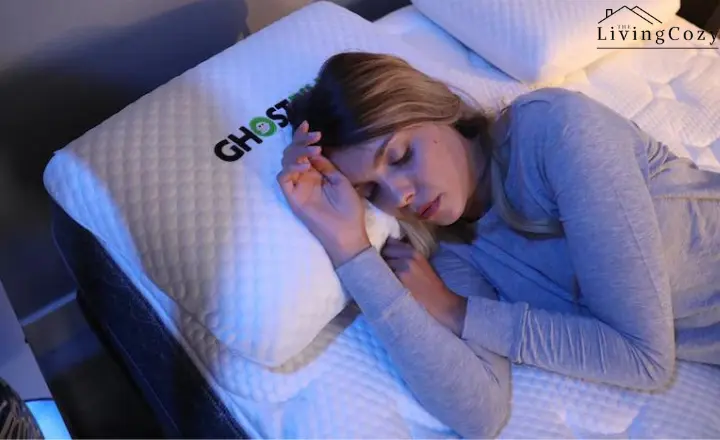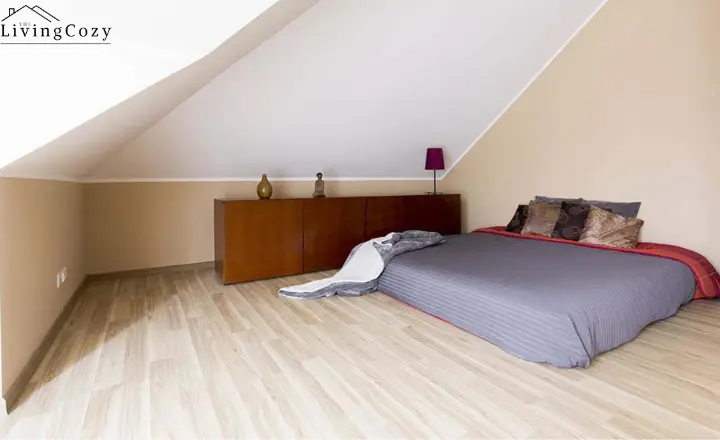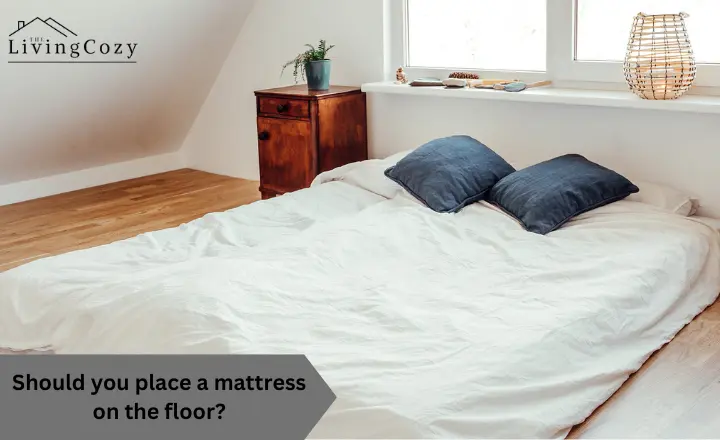The article about that is, Should you place a mattress on the floor? Placing a mattress on the floor can be a matter of personal preference and practicality.
Some people find that placing their mattresses directly on the floor can provide a minimalist and modern aesthetic to their bedroom. It can also save money on purchasing a bed frame or box spring.
Disadvantages of using your mattress on the floor:
There are several disadvantages to using your mattress on the floor.
Poor ventilation:
Placing your mattress directly on the floor can restrict ventilation, creating an environment conducive to mold and mildew growth. Without proper airflow, moisture can become trapped, leading to potential health hazards and damage to the mattress.
Mold and mildew thrive in damp, dark environments, so it’s essential to consider alternative methods for supporting your mattress.
To prevent these issues, consider using a slatted bed frame or a platform bed to elevate your mattress off the floor. This will allow air to circulate underneath, reducing the risk of mold and mildew formation.
Regularly airing and vacuuming your mattress can help mitigate moisture buildup and maintain a healthy sleep environment.
Exposure to bugs and pests:

Sleeping on the floor can expose you to pests like spiders, bed bugs, and rodents. In ancient times, raising beds was a way to minimize the risk of these pests crawling onto the bed.
In modern times, there are ways to mitigate the risk of pests while sleeping on the floor. Using a high-quality mattress or sleeping pad can create a barrier between you and the floor, reducing the likelihood of encountering pests.
Sleeping on the floor may provoke allergies:
Sleeping on the floor can potentially provoke allergies for some individuals. Dust, pet dander, and other allergens can accumulate on the floor, increasing exposure while sleeping.
Carpets and rugs can trap dust mites and other allergens, which may exacerbate allergy symptoms for sensitive people.
If you find sleeping on the floor is causing allergy symptoms such as sneezing, itching, or congestion, consider using a mattress or sleeping surface that can be easily cleaned and maintained to reduce allergen exposure.
Regular vacuuming and cleaning of the sleeping area can also help minimize allergen buildup and improve sleep quality. If allergies persist, it’s essential to consult with a healthcare professional to identify specific triggers and develop an appropriate management plan.
Lack of support:
Ideally, pairing your mattress with its matching bed base can provide more support and help extend the life of the mattress.
When a mattress is used with its intended base, it ensures that the two are designed to work together to provide optimal comfort and support. This can also prevent premature wear and tear on the mattress, ultimately prolonging its lifespan.
Using a matching bed base can also contribute to better sleep quality. Combining a compatible mattress and base can promote proper spinal alignment and reduce pressure points, leading to a more restful and comfortable sleep experience.
Therefore, it’s beneficial to invest in a bed base specifically designed for your mattress to maximize its performance and longevity.
It may not be easy to get in and out of bed comfortably:

If you find it challenging to get in and out of bed comfortably, you can try a few things to make the process easier.
First, consider investing in a bed rail or grab bar to provide extra support and stability when getting in and out of bed. These can be especially helpful for individuals with mobility issues or balance concerns.
Adjusting the height of your bed may also help improve comfort. You can use risers to elevate the bed to a more accessible height, making transitioning from seated to standing easier.
Exposure to drafts:
Sleeping on the floor can expose you to colder air, which may seem appealing in warmer months but can lead to health issues.
The lack of insulation from the ground can make you more susceptible to feeling cold, potentially leading to headaches and muscle pain. Direct contact with the floor can cause skin irritations and discomfort.
In colder months, sleeping on the floor can increase your risk of catching a cold due to prolonged exposure to low temperatures.
It’s essential to consider these potential health consequences before sleeping on the floor regularly.
To mitigate these issues, using a mattress or sleeping pad for insulation and maintaining a comfortable room temperature can help minimize the impact of sleeping on the floor.
You may invalidate your manufacturer’s guarantee:
When choosing a mattress base, paying attention to the manufacturer’s specifications is essential. Many mattresses require a specific type of base for optimal support and performance.
For example, some memory foam mattresses may require a solid platform or slatted base with minimal spacing to prevent sagging and maintain proper support.
Using the recommended base ensures that your mattress will function as intended and can also help maintain its warranty validity.
It’s also worth noting that using the wrong base type can affect your mattress’s comfort and longevity, so it’s best to follow the manufacturer’s guidelines for the best results.
If you have to put your mattress on the floor:

Putting your mattress on the floor can be a practical and cost-effective solution, especially if you’re in a temporary living situation or don’t want to invest in a bed frame.
Placing your mattress on the floor can restrict airflow, potentially leading to mold and mildew growth. To mitigate this, consider using a breathable barrier between the mattress and the floor, such as a moisture-resistant mat or a wooden pallet.
Your mattress on the floor may make it more susceptible to dust and dirt accumulation. Regularly vacuuming and cleaning the area around the mattress can help minimize this issue.
It’s also essential to ensure the floor is clean and free from sharp objects that could damage the mattress.
While putting your mattress on the floor may not be ideal for everyone, proper care, and maintenance can serve as a functional sleeping arrangement.
Final thoughts Should you place a mattress on the floor?
In the above content, we discuss whether Should you place a mattress on the floor. It can have both benefits and drawbacks. It may provide a minimalist, sleek look to your bedroom while saving space and reducing the need for a bed frame.
It could also lead to poor air circulation, increased exposure to dust and pests, and potential damage to the mattress.
The decision to place a mattress on the floor should be based on personal preference, lifestyle, and health considerations.
Before making a final choice, weighing these factors carefully and considering alternatives such as low-profile bed frames or platforms is essential. Make an informed decision that aligns with your needs and preferences for a comfortable and healthy sleep environment.
FAQ’s:
Can I use a box spring with a mattress on the floor?
You can use a box spring with a mattress on the floor for support.
Will my warranty be affected if I place my mattress on the floor?
It may void the warranty if the manufacturer specifies that the mattress should not be placed directly on the floor.


